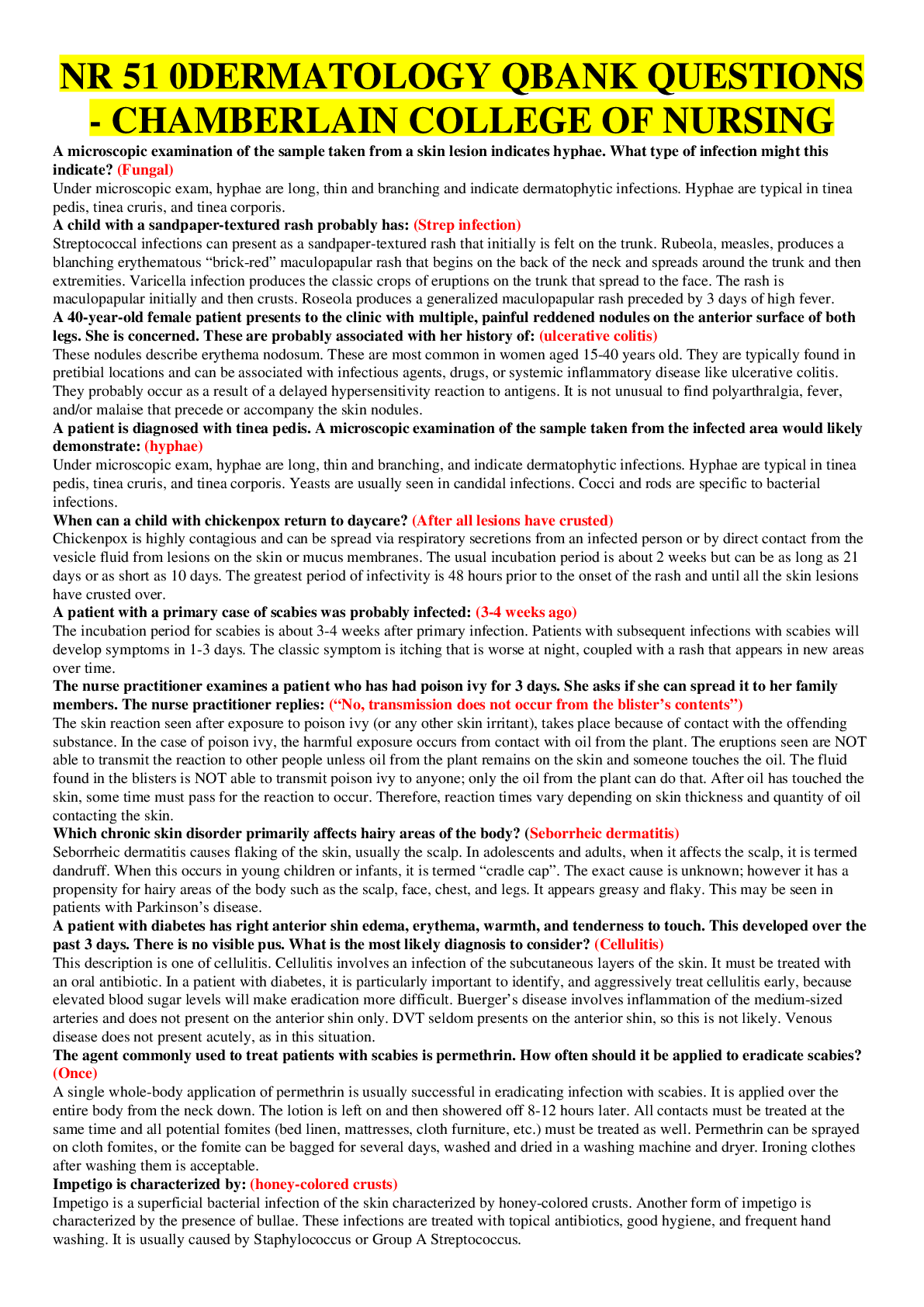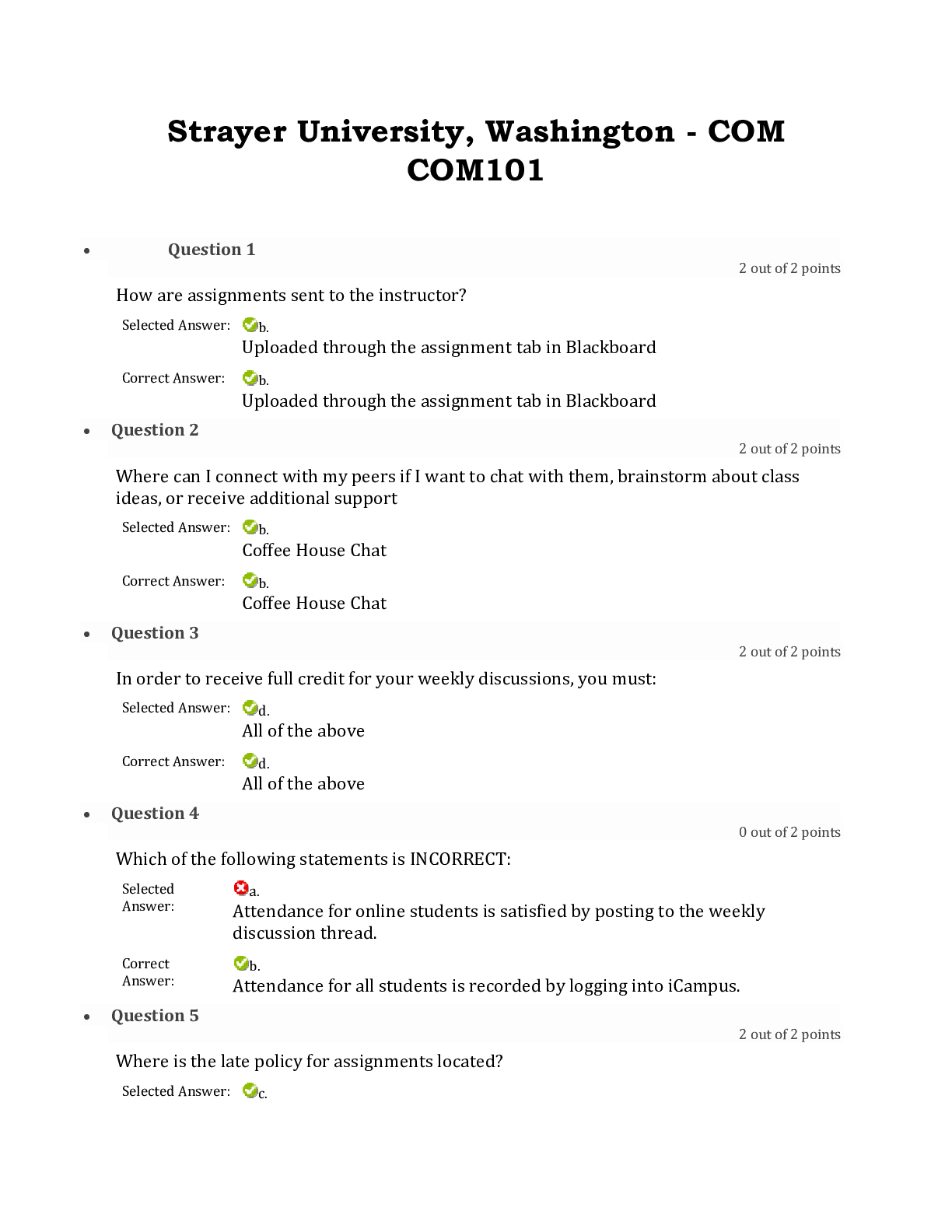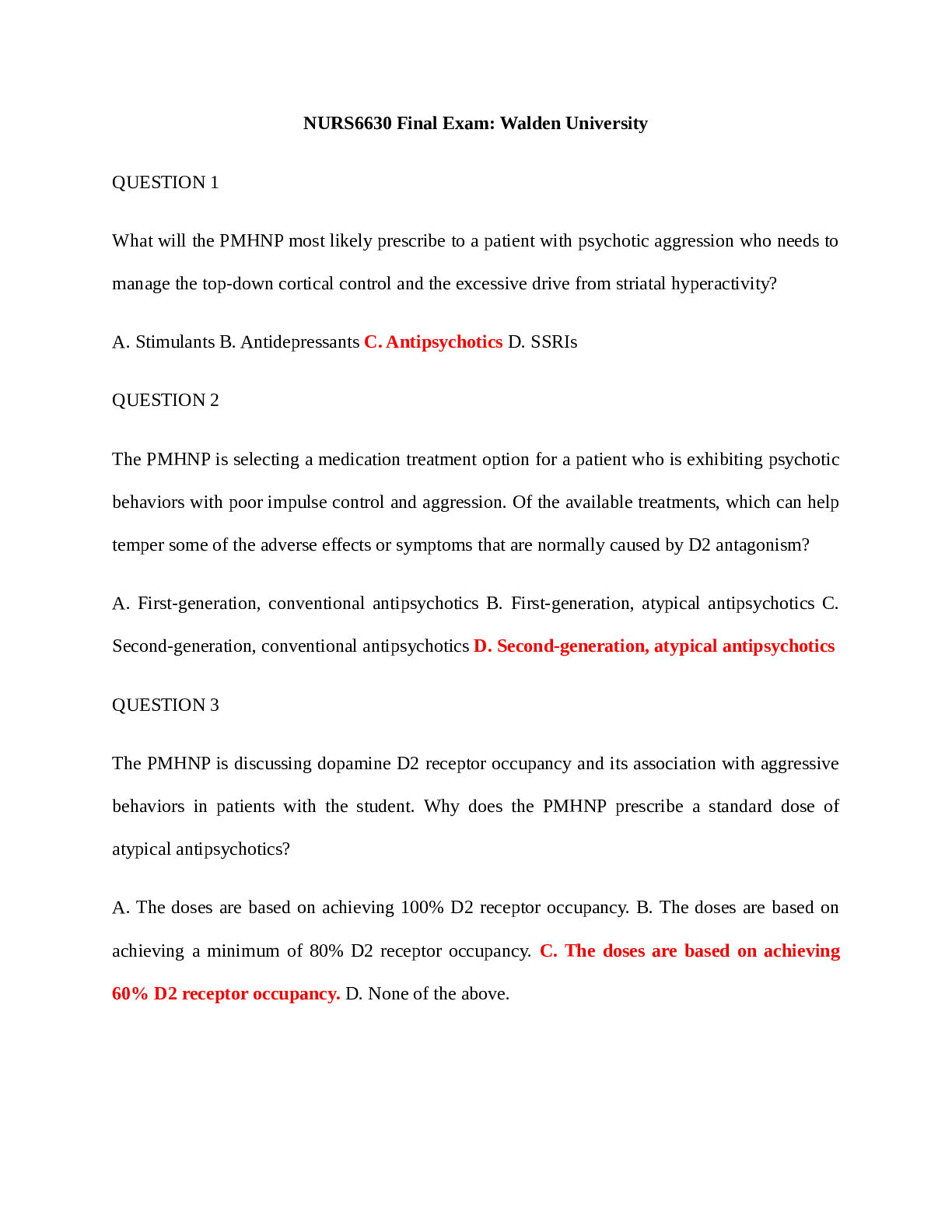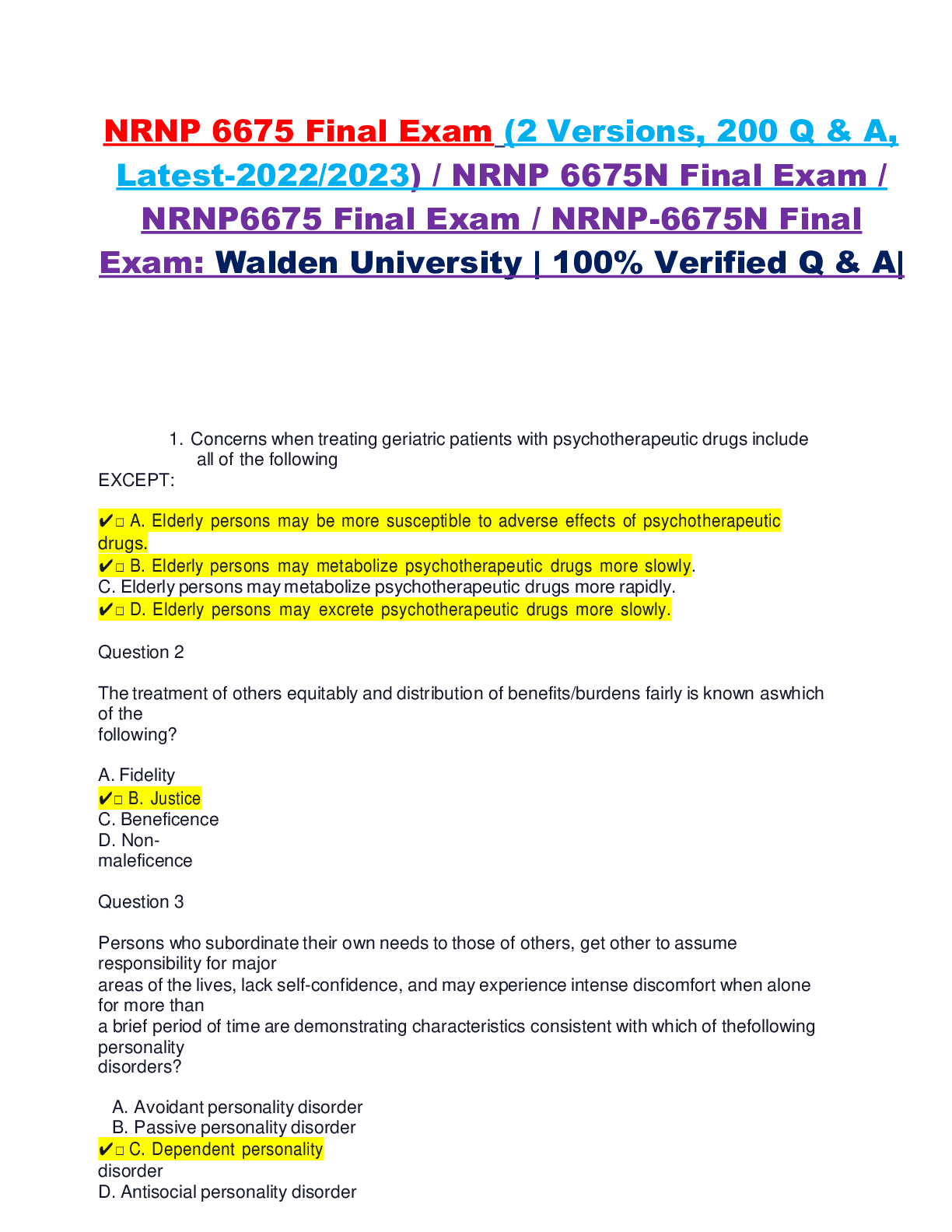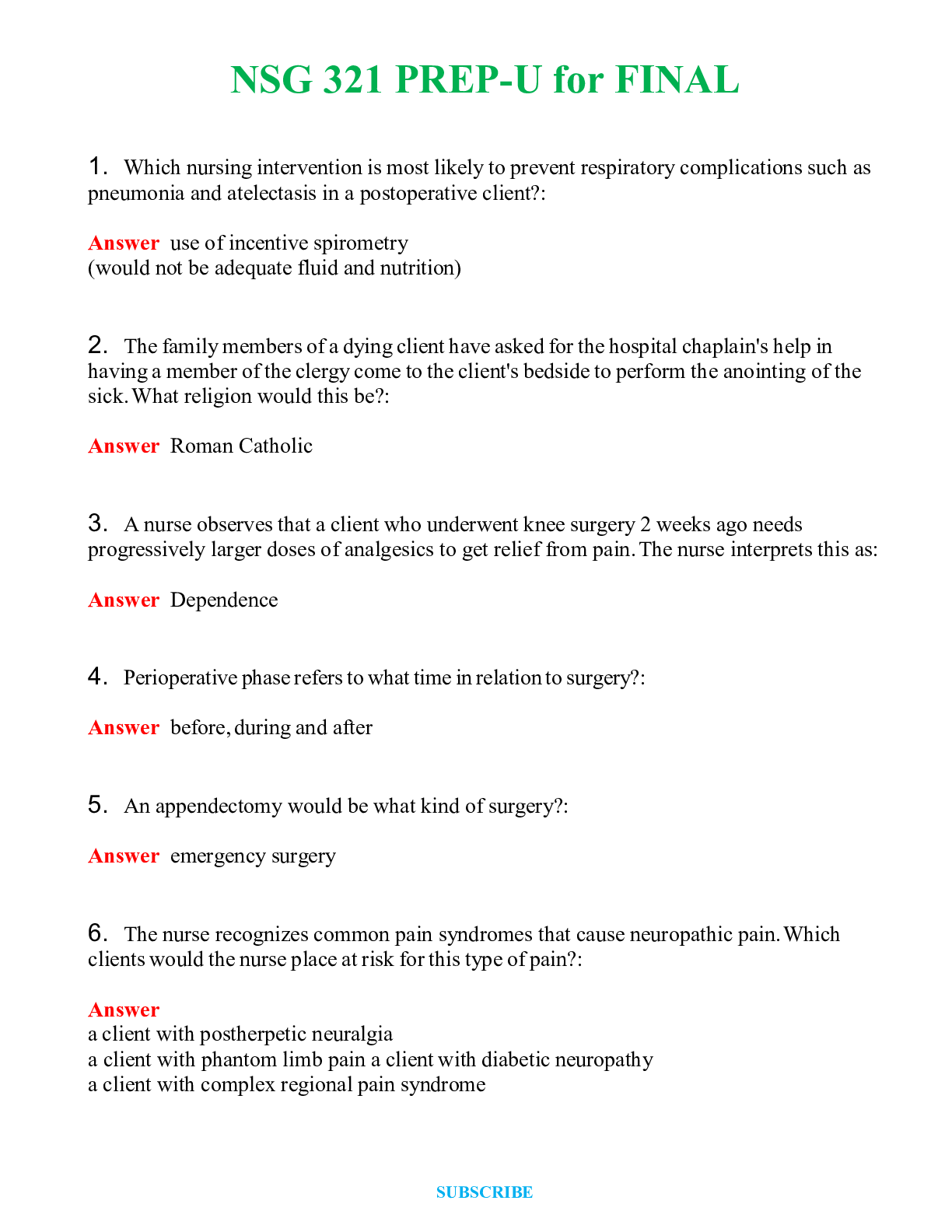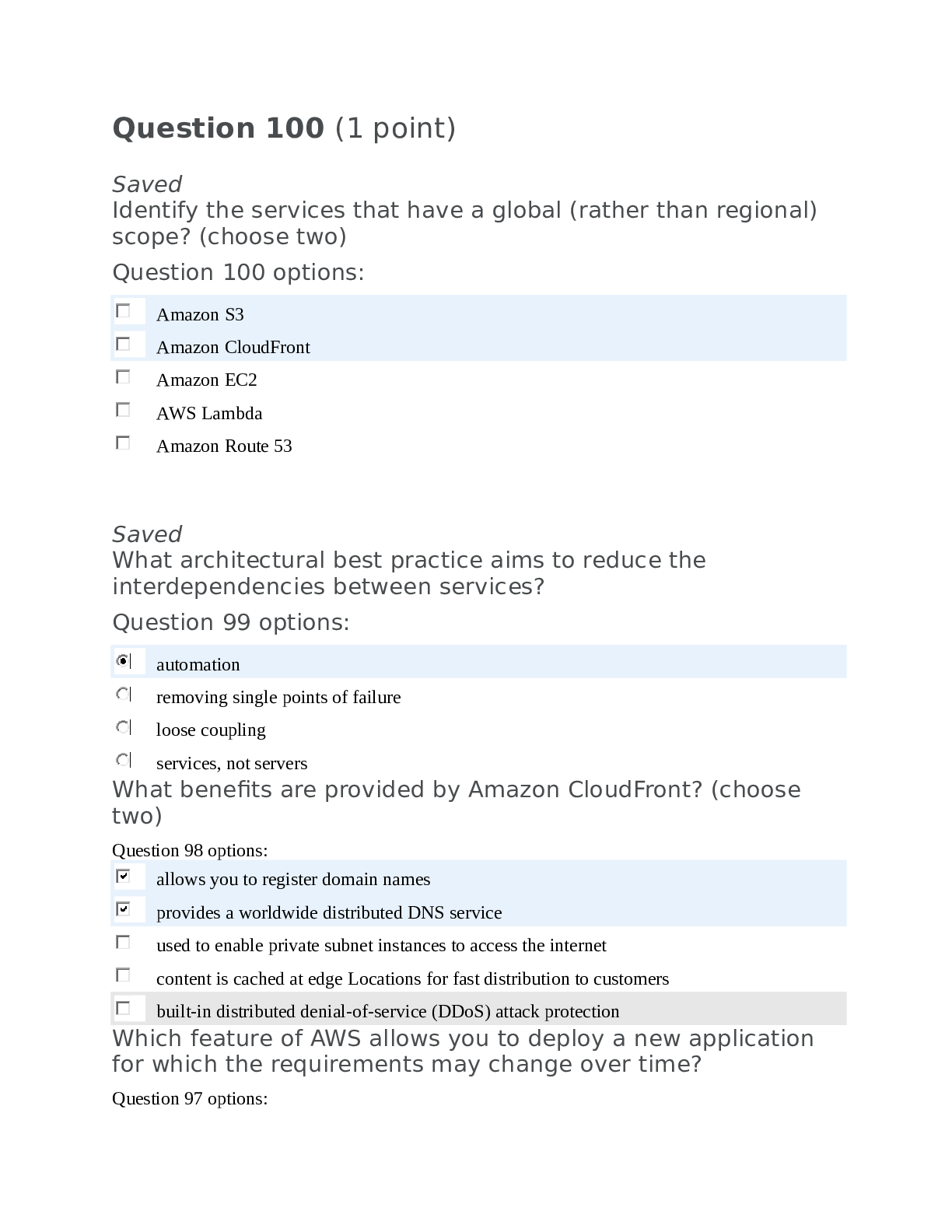NURS-6630C-7/NURS-6630N-7-Approaches to Treatment2019
Document Content and Description Below
NURS-6630C-7/NURS-6630N-7-Approaches to Treatment2019 Course NURS-6630C-7/NURS-6630N-7-Approaches to Treatment2019 Winter Qtr 11/25-02/16-PT27 Test Week 11 Final Exam Started 2/9/20 10:02 AM Submi... tted 2/9/20 11:48 AM Due Date 2/10/20 1:59 AM Status Completed Attempt Score 62 out of 75 points Time Elapsed 1 hour, 45 minutes out of 2 hours Results Displayed Submitted Answers Question 1 1 out of 1 points The parents of a 10 year old girl diagnosed with ADHD ask if the PMHNP can prescribe something to help their daughter’s ADHD that is not a stimulant. Which of the following responses is correct? Selected Answer: c. "I can prescribe atomoxetine for your daughter. This medication help ADHD symptoms and is not considered a stimulant." Question 2 1 out of 1 points A patient with chronic insomnia asks the PMHNP if they can frst try an over-the-counter (OTC) medication before one that needs to be prescribed to help the patient sleep. Which is the best response by the PMHNP? Selected Answer: d. “You can get melatonin over the counter, which will help with sleep onset.” Question 3 0 out of 1 points Methylphenidate, amphetamine, and cocaine are alike because all three _____________________. Selected Answer: c. act as depressants. Question 4 0 out of 1 points An elderly woman with a history of Alzheimer’s disease, coronary artery disease, and myocardial infarction had a fall at home 3 months ago that resulted in her receiving an open reduction internal fxation. While assessing this patient, the PMHNP is made aware that the patient continues to experience mild to moderate pain. What is the PMHNP most likely to do?Selected Answer: b. Order an X-ray because it is possible that she dislocated her hip. Question 5 1 out of 1 points The PMHNP is caring for a patient who openly admitted to drinking a quart of vodka daily. Prior to prescribing this patient disulfram (Antabuse), it is important for the PMHNP to: Selected Answer: c. Evaluate the patient’s willingness to abstain from alcohol Question 6 0 out of 1 points Insomnia is caused by excessive nighttime arousal. The PMHNP is likely to prescribe which of the following to treat insomnia? Selected Answer: d. A negative allosteric modulator of GABA-A receptors Question 7 1 out of 1 points The nursing staff asks the PMHNP for additional education regarding the treatment of agitation in dementia patients. Which of the following is correct? Selected Answer: b. The nurse should attempt to determine how the patient's environment may be impacting the patient's mood. Question 8 1 out of 1 points The PMHNP is evaluating a 30-year-old female patient who states that she notices pain and a drastic change in mood before the start of her menstrual cycle. The patient states that she has tried diet and lifestyle changes but nothing has worked. What will the PMHNP most likely do? Selected Answer: d. Prescribe desvenlafaxine (Pristiq), 50 mg daily Question 9 1 out of 1 points The PMHNP is caring for a patient who reports excessive arousal at nighttime. What could the PMHNP use for a time-limited duration to shift the patient’s brain from a hyperactive state to a sleep state? Selected Answer: b. Benzodiazepi nes Question 10 1 out of 1 pointsWhich of these characteristics does NOT meet the criteria for probably Alzheimer's dementia? Selected Answer: b. Sudden onset Question 11 0 out of 1 points A patient with a new diagnosis of diabetic peripheral neuropathy is switched from sertraline (ZOLOFT) to duloxetine (CYMBALTA). The patient asks why they are switching treatment. What is the best response? Selected Answer: c. Sertraline increases norepinephrine and serotonin. You need a medication that only increases serotonin. Question 12 1 out of 1 points Daniel is a 33 year old patient with ADHD and multiple comorbidities: mood disorder, alcohol abuse, ADHD, and nicotine dependence. Which comorbidity should be treated frst? Selected Answer: c. Alcohol abuse disorder Question 13 1 out of 1 points Parents of a 12-year-old boy want to consider attention defcit hyperactivity disorder (ADHD) medication for their son. Which medication would the PMHNP start? Selected Answer: a. All of these could potentially treat their son’s symptoms. Question 14 0 out of 1 points Which of the following is considered as a disruptive/impulse control behavior? Selected Answer: a. Skin picking Question 15 1 out of 1 points The PMHNP is performing a quality assurance peer review of the chart of another PMHNP. Upon review, the PMHNP reviews the chart of an older adult patient in long-term care facility who has chronic insomnia. The chart indicates that the patient has been receiving hypnotics on a nightly basis. What does the PMHNP fnd problematic about this documentation? Selected Answer: a. Hypnotics have prolonged half-lives that can cause drug accumulation in the elderly. Question 16 1 out of 1 points The PMHNP understands that slow-dose extended release stimulants are most appropriate for which patient with ADHD? Selected Answer: d. 8-year-old patient Question 17 1 out of 1 points Mr. Peterson is meeting with the PMHNP to discuss healthier dietary habits. With a BMI of 33, Mr. Peterson is obese and needs to modify his food intake. “Sometimes I think I’m addicted to food the way some people are addicted to drugs,” he says. Which statement best describes the neurobiological parallels between food and drug addiction? Selected Answer: c. There is decreased activation of the prefrontal cortex. Question 18 0 out of 1 points Which of the following substances has the highest probability of becoming dependent after a single use? Selected Answer: a. Heroi n Question 19 1 out of 1 points A patient recovering from shingles presents with tenderness and sensitivity to the upper back. He states it is bothersome to put a shirt on most days. This patient has end stage renal disease (ESRD) and is scheduled to have hemodialysis tomorrow but states that he does not know how he can lie in a recliner for 3 hours feeling this uncomfortable. What will be the PMHNP’s priority? Selected Answer: d. Prescribe lidocaine 5% Question 20 1 out of 1 points A patient is prescribed D-methylphenidate, 10-mg extended-release capsules. What should the PMHNP include when discussing the side effects with the patient? Selected Answer: a. The medication can affect your blood pressure. Question 21 0 out of 1 points An interneuron is a neuron that has its cell body, dendrites, and axon within the spinalcord. The neuron can be considered excitatory if it contains ____________ or inhibitory if it contains ____________. Selected Answer: b. Seratonin / Dopamine Question 22 1 out of 1 points The PMHNP is treating a patient with depression and fbromyalgia. The PMHNP chooses to prescribe a treatment that may help treat the patient's fbromyalgia and depressive symptoms. Which medication is the PMHNP likely to choose? Selected Answer: c. Amitriptyline (ELAVIL) Question 23 1 out of 1 points Brandon is a non-compliant patient that presents to the clinic asking for help with his alcohol dependence. The PMHNP evaluates the patient and determines a long-acting injection that blocks the mu-receptors would be the best treatment option for Brandon. Which medication should the PMHNP prescribe? Selected Answer: b. Naltrexone (VIVITROL) Question 24 1 out of 1 points Which patient will receive a lower dose of guanfacine? Selected Answer: a. Patient with kidney disease Question 25 1 out of 1 points Alcohol enhances inhibition at ____________ synapses and reduces excitation at ______________ synapses. Selected Answer: b. GABA / Glutamate Question 26 1 out of 1 points An opioid-naive patient is taking MS Contin (morphine sulfate) to treat his pain that is secondary to cancer. Under what circumstances would the PMHNP order naloxone (Narcan) IM/SQ? Selected Answer: a. The patient’s vital signs are 98.4F temp, 88 pulse, 104/62 blood pressure, and 8 respirations. Question 27 1 out of 1 points The PMHNP is meeting with the parents of an 8-year-old patient who is receiving an initial prescription for D-amphetamine. The PMHNP demonstrates appropriate prescribing practices when she prescribes the following dose: Selected Answer: c. The child will be prescribed 2.5 mg. Question 28 1 out of 1 points The PMHNP is treating a patient for fbromyalgia and is considering prescribing milnacipran (Savella). When prescribing this medication, which action is the PMHNP likely to choose? Selected Answer: c. Split the daily dose into two doses after the frst day. Question 29 1 out of 1 points An adult patient presents with a history of alcohol addiction and attention defcit hyperactivity disorder (ADHD). Given these comorbidities, the PMHNP determines which of the following medications may be the best treatment option? Selected Answer: b. Atomoxetine (Strattera) Question 30 0 out of 1 points The PMHNP is evaluating a 7 year old pediatric patient for the treatment of ADHD. The PMHNP decides to prescribe a medication that is selective for alpha-2A receptors that has a lower incidence of sedation and hypotension. Which agent did the PMHNP prescribe? Selected Answer: a. Atomoxetine (STRATTERA) Question 31 1 out of 1 points The PMHNP is discussing dopamine D2 receptor occupancy and its association with aggressive behaviors in patients with the student. Why does the PMHNP prescribe a standard dose of atypical antipsychotics? Selected Answer: a. The doses are based on achieving 60% D2 receptor occupancy. Question 32 1 out of 1 points Antihistamines may cause side effects such as blurred vision, constipation, memory problems, and dry mouth. This is due to the _______________ effects of antihistamines.Selected Answer: b. Anticholiner gic Question 33 1 out of 1 points The PMHNP is assessing a patient who has expressed suicidal intent and is now stating that he is hearing voices and sees people chasing him. The PMHNP identifes these symptoms to be associated with which of the following? Selected Answer: d. “Bath salt” intoxication Question 34 1 out of 1 points A patient is being prescribed bupropion and is concerned about the side effects. What will the PMHNP tell the patient regarding bupropion? Selected Answer: c. It can cause cardiac arrhythmias. Question 35 1 out of 1 points A patient with chronic back pain has been prescribed a serotonin-norepinephrine reuptake inhibitor (SNRI). How does the PMHNP describe the action of SNRIs on the inhibition of pain to the patient? Selected Answer: a. “The SNRI can increase noradrenergic neurotransmission in the descending spinal pathway to the dorsal horn.” Question 36 1 out of 1 points Mike wants to quit smoking. He has tried nicotine replacement and varenicline without success. He has asked for another medication to help him kick his habit. The PMHNP decides to try a medication that increases dopamine by prescribing a medications that can increase both norepinephrine and dopamine. Which medication did the PMHNP prescribe? Selected Answer: c. Bupropion (ZYBAN) Question 37 1 out of 1 points Individuals who suffer from an addiction often increase the dose of medication to achieve the desired effect. The need to increase the dose to reach the safe effect is due to __________________. Selected Answer: b. toleran ce Question 38 1 out of 1 points A patient you have been evaluating was admitted to the hospital with some abnormal lab work. Hematology/oncology was consulted and diagnoses the patient with aplastic anemia and agranulocytosis. Which medication was likely the culprit? Selected Answer: d. Carbamazepi ne Question 39 1 out of 1 points A 26-year-old female patient with nicotine dependence and a history of anxiety presents with symptoms of attention defcit hyperactivity disorder (ADHD). Based on the assessment, what does the PMHNP consider? Selected Answer: d. ADHD is often not the focus of treatment in adults with comorbid conditions. Question 40 1 out of 1 points Neal is complaining of restless leg syndrome and insomnia. Which frst-line medication should the PMHNP prescribe to treat both? Selected Answer: b. Ripinirole (REQUIP) Question 41 1 out of 1 points A 63-year-old patient presents with the following symptoms. The PMHNP determines which set of symptoms warrant prescribing a medication? Select the answer that is matched with an appropriate treatment. Selected Answer: c. Impairment in the ability to learn and retain new information is most problematic, and an appropriate treatment option would be donepezil. Question 42 0 out of 1 points Which of these statements is correct? Selected Answer: b. EPS is common with aripiprazole (ABILIFY) Question 43 1 out of 1 points The PMHNP is selecting a medication treatment option for a patient who is exhibiting psychotic behaviors with poor impulse control and aggression. Of the available treatments, which can help temper some of the adverse effects or symptoms that are normally causedby D2 antagonism? Selected Answer: a. Second-generation, atypical antipsychotics Question 44 1 out of 1 points A patient with fbromyalgia and major depression needs to be treated for symptoms of pain. Which is the PMHNP most likely to prescribe for this patient? Selected Answer: a. Duloxetine (Cymbalta) Question 45 1 out of 1 points You have been consulted to evaluate a patient who presents with symptoms of dementia. The patient is experiencing memory defcit, aphasia, apraxia, and agnosia. Which treatment option is best for this patient? Selected Answer: b. Donepezil (ARICEPT) Question 46 1 out of 1 points A patient with hypersexual disorder is being assessed for possible pharmacologic treatment. Why does the PMHNP prescribe an antiandrogen for this patient? Selected Answer: d. It will block testosterone. Question 47 1 out of 1 points A patient with gambling disorder and no other psychiatric comorbidities is being treated with pharmacological agents. Which drug is the PMHNP most likely to prescribe? Selected Answer: a. Naltrexo ne Question 48 1 out of 1 points A patient on chronic opioids is currently on oxycodone ER (OxyContin). The PMHNP is consulted to treat underlying depression. Under which circumstance should the PMHNP order naloxone (NARCAN)? Selected Answer: c. The patient is somnolent and has 7 respirations per minute. Question 491 out of 1 points An 8-year-old patient presents with severe hyperactivity, described as “ants in his pants.” Based on self-report from the patient, his parents, and his teacher; attention defcit hyperactivity disorder (ADHD) is suspected. What medication is the PMNHP most likely to prescribe? Selected Answer: d. Methylphenidate (Ritalin, Concerta) Question 50 1 out of 1 points A 71-year-old male patient comes to an appointment with his 65-year-old wife. They are both having concerns related to her memory and ability to recognize faces. The PMNHP is considering prescribing memantine (Namenda) based on the following symptoms: Selected Answer: c. Amnesia, apraxia, agnosia Question 51 1 out of 1 points Heather is admitted for opioid withdrawals and detoxifcation. The PMHNP decides to prescribe an alpha-2 adrenergic agonist to reduce the symptoms of autonomic hyperactivity during withdrawal and aid in the detoxifcation process. Which medication did the PMHNP prescribe? Selected Answer: d. Clonidin e Question 52 0 out of 1 points An adult patient presents with a history of substance-use disorder and attention defcit hyperactivity disorder (ADHD). Which of the following treatment options is best for this patient? Selected Answer: b. Fluoxeti ne Question 53 1 out of 1 points The PMHNP is providing a workshop for pediatric nurses, and a question is posed about noradrenergic agents to treat ADHD. Which of the following noradrenergic agents have norepinephrine reuptake inhibitor (NRI) properties that can treat ADHD? Selected Answer: d. Both Desipramine and Atomoxetine Question 54 1 out of 1 points The PMHNP is teaching a patient with a sleep disorder about taking diphenhydramine(Benadryl). The patient is concerned about the side effects of the drug. What can the PMHNP teach the patient about this treatment approach? Selected Answer: a. “It can cause blurred vision.” Question 55 1 out of 1 points Karen completes the Epworth sleepiness scale and scores abnormally high. She is diagnosed with narcolepsy. The PMHNP prescribes a wake-promoting agent that is a weak dopamine transporter antagonist. Which medication did the PMHNP prescribe? Selected Answer: b. Modafanil (PROVIGIL) Question 56 1 out of 1 points The PMHNP wants to use a symptom-based approach to treating a patient with fbromyalgia. How does the PMHNP go about treating this patient? Selected Answer: d. Matching the patient’s symptoms with the malfunctioning brain circuits and neurotransmitters that might mediate those symptoms. Question 57 1 out of 1 points Jacob is a 7-year-old pediatric patient who has signifcant oppositional symptoms associated with his ADHD diagnosis. What is the best treatment for this patient? Selected Answer: a. Prescribe methylphenidate and augment with guanfacine. Question 58 1 out of 1 points A 72-year-old male patient is diagnosed with frontotemporal dementia and presents with aggression and agitation. The PMHNP is consulted and decided to prescribe which of the following? Selected Answer: b. Citalopram (CELEXA) Question 59 1 out of 1 points A patient with chronic insomnia and depression is taking trazodone (Oleptro) but complains of feeling drowsy during the day. What can the PMHNP do to reduce the drug’s daytime sedating effects? Selected Answer: a. Give the medicine at night and lowerthe dose Question 60 1 out of 1 points Even though both of these medications are useful in the treatment of ADHD, their actions are different. Atomoxetine is a selective ______________________ reuptake inhibitor, while bupropion is a selective __________________ reuptake inhibitor. Selected Answer: b. Norepinephrine / norepinephrinedopamine Question 61 1 out of 1 points The PMHNP is assessing a patient who presents with elevated levels of brain amyloid as noted by positron emission tomography (PET). What other factors will the PMHNP consider before prescribing medication for this patient, and what medication would the PMHNP want to avoid given these other factors? Selected Answer: d. ApoE4 genotype and avoid antihistamines if possible and Type 2 diabetes and avoid olanzapine Question 62 1 out of 1 points A 72-year-old male patient is in the early stages of Alzheimer’s disease. The PMHNP determines that improving memory is a key consideration in selecting a medication. Which of the following would be an appropriate choice? Selected Answer: d. All of these are correct Question 63 0 out of 1 points A patient presents with psychotic aggression. Which treatment option is best for a patient presenting with psychotic aggression due to impaired top-down cortical control and excessive drive from striatal hyperactivity? Selected Answer: b. Antipsychoti cs Question 64 1 out of 1 points The PMHNP wants to prescribe Mr. Barber a mood stabilizer that will target aggressive and impulsive symptoms by decreasing dopaminergic neurotransmission. Which mood stabilizer will the PMHNP select? Selected Answer: d. Lithium (Lithane) Question 65 1 out of 1 pointsWhat will the PMHNP most likely prescribe to a patient with psychotic aggression who needs to manage the top-down cortical control and the excessive drive from striatal hyperactivity? Selected Answer: d. Antipsychoti cs Question 66 0 out of 1 points Sandra complains of constipation after being on quetiapine (SEROQUEL) for several weeks. Constipation is likely caused by the binding of quetiapine (SEROQUEL) to which receptor? Selected Answer: a. D1 Question 67 1 out of 1 points Mrs. Kenner is concerned that her teenage daughter spends too much time on the Internet. She inquires about possible treatments for her daughter’s addiction. Which response by the PMHNP demonstrates understanding of pharmacologic approaches for compulsive disorders? Selected Answer: c. “There are no evidence-based treatments for Internet addiction, but there are behavioral therapies your daughter can try.” Question 68 1 out of 1 points The PMHNP is assessing a 49-year-old male with a history of depression, post-traumatic stress disorder (PTSD), alcoholism with malnutrition, diabetes mellitus type 2, and hypertension. His physical assessment is unremarkable with the exception of peripheral edema bilaterally to his lower extremities and a chief complaint of pain with numbness and tingling to each leg 5/10. The PMHNP starts this patient on a low dose of doxepin (Sinequan). What is the next action that must be taken by the PMHNP? Selected Answer: a. Order liver function tests. Question 69 1 out of 1 points Why does the PMHNP avoid prescribing clozapine (Clozaril) as a frst-line treatment to the patient with psychosis and aggression? Selected Answer: c. There is too high a risk of serious adverse side effects. Question 70 1 out of 1 points Kevin is an adolescent who has been diagnosed with kleptomania. His parents are interested in seeking pharmacological treatment. What does the PMHNP tell the parentsregarding his treatment options? Selected Answer: b. “Naltrexone may be an appropriate option to discuss.” Question 71 0 out of 1 points Jerry presents to the clinic for his four-week follow-up after starting trazodone for insomnia. How does trazodone help with insomnia? Selected Answer: d. Trazodone increases the level of serotonin in the brain at low doses. Question 72 1 out of 1 points The PMHNP is caring for a patient who experiences too much overstimulation and anxiety during daytime hours. The patient agrees to a pharmacological treatment but states, “I don’t want to feel sedated or drowsy from the medicine.” Which decision made by the PMHNP demonstrates proper knowledge of this patient’s symptoms and appropriate treatment options? Selected Answer: b. Avoiding prescribing the patient a drug that blocks H1 receptors Question 73 1 out of 1 points The PMHNP is assessing a patient who will be receiving phentermine (Adipex-P)/topiramate (Topamax) (Qsymia). Which of the following conditions/diseases will require further evaluation before this medication can be prescribed? Selected Answer: b. Cardiovascular disease Question 74 1 out of 1 points The parents of a 7-year-old patient with ADHD are concerned about the effects of stimulants on their child. The parents prefer to start pharmacological treatment with a nonstimulant. Which medication will the PMHNP will most likely prescribe? Selected Answer: c. Stratte ra Question 75 1 out of 1 points The PMHNP is caring for a patient with fbromyalgia. Which second-line treatment does the PMHNP select that may be effective for managing this patient’s pain? Selected a.Answer: Imipramine (Tofranil) Question 76 0 out of 0 points When completng this exam, did you comply with Walden University’s Code of Conduct including the expectatons for academic integrity? Selected Answer: Ye s [Show More]
Last updated: 1 year ago
Preview 1 out of 15 pages

Reviews( 0 )
Document information
Connected school, study & course
About the document
Uploaded On
Oct 08, 2021
Number of pages
15
Written in
Additional information
This document has been written for:
Uploaded
Oct 08, 2021
Downloads
0
Views
31

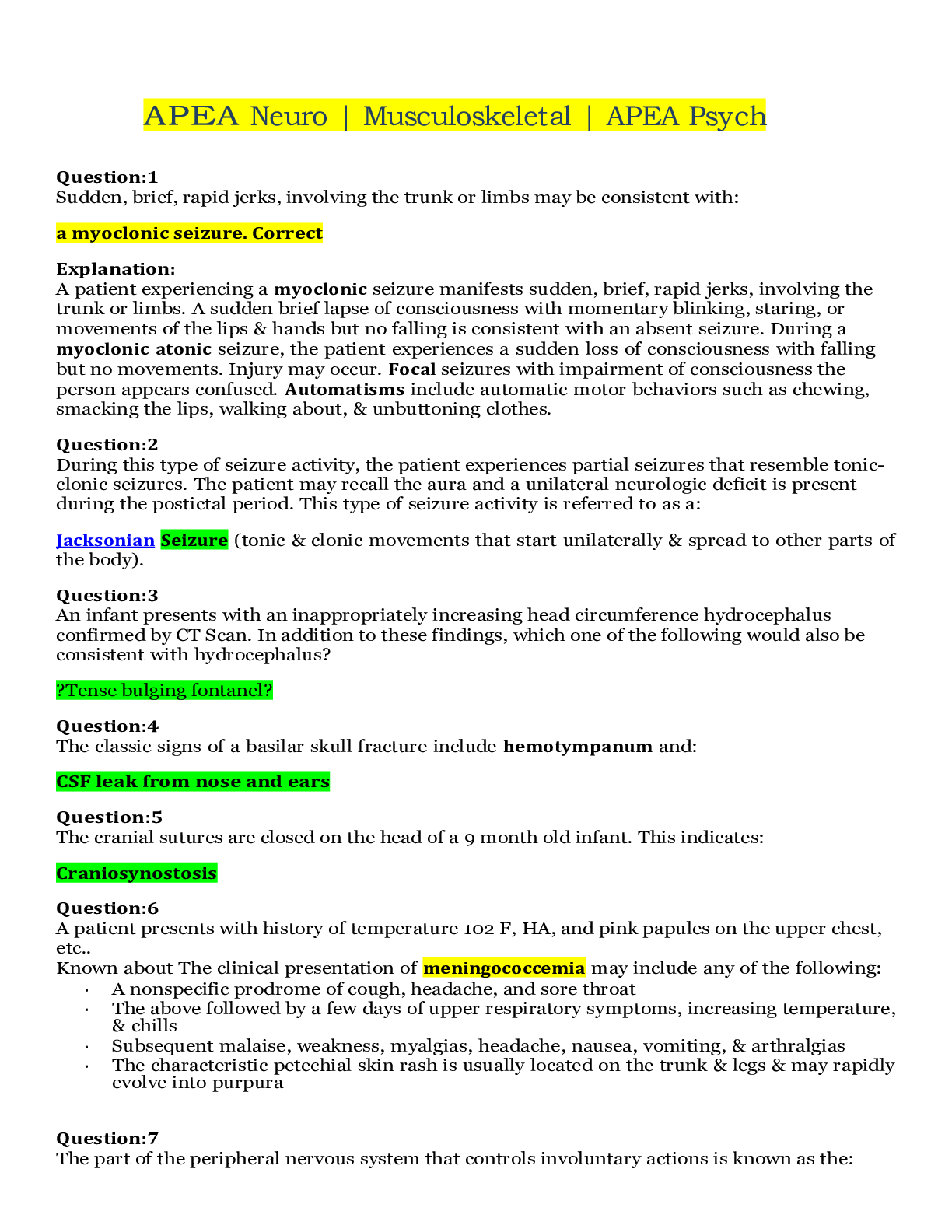


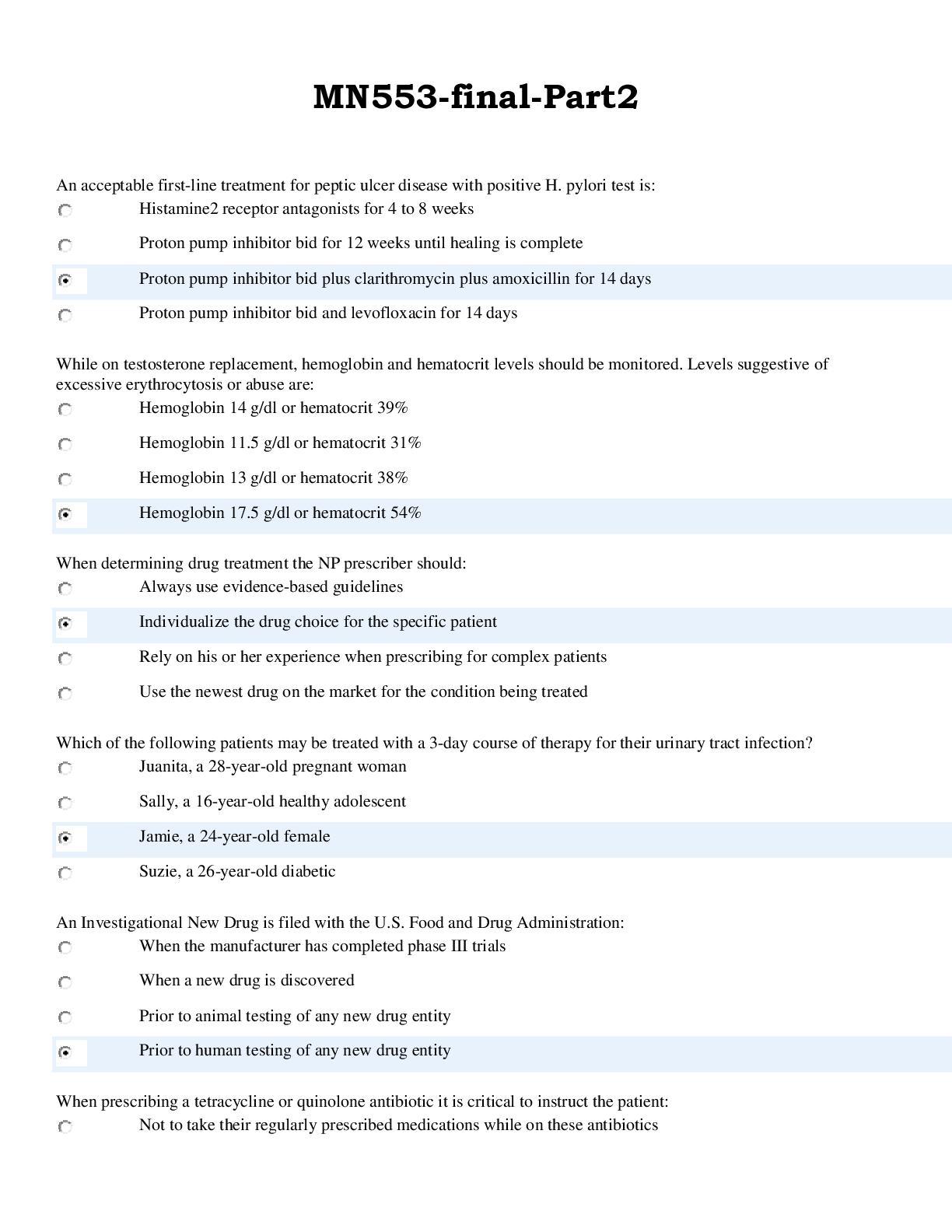
.png)
